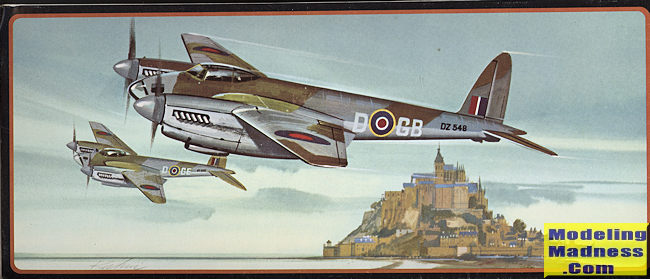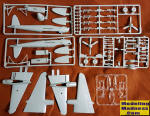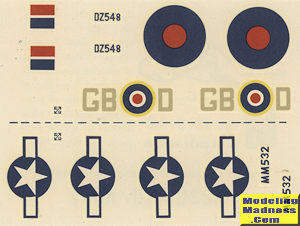
AMT(Frog) 1/72 Mosquito Mk.IV
| KIT #: | A631 |
| PRICE: | $1.00 SRP (when new) |
| DECALS: | Two options |
| REVIEWER: | Scott Van Aken |
| NOTES: | Reboxed Frog kit |

| HISTORY |
The de Havilland DH.98 Mosquito is a British multi-role combat aircraft with a two-man crew which served during and after the Second World War. It was one of few operational front-line aircraft of the era constructed almost entirely of wood and was nicknamed "The Wooden Wonder". The Mosquito was also known affectionately as the "Mossie" to its crews. Originally conceived as an unarmed fast bomber, the Mosquito was adapted to roles including low to medium-altitude daytime tactical bomber, high-altitude night bomber, pathfinder, day or night fighter, fighter-bomber, intruder, maritime strike aircraft, and fast photo-reconnaissance aircraft. It was also used by the British Overseas Airways Corporation (BOAC) as a fast transport to carry small high-value cargoes to, and from, neutral countries, through enemy-controlled airspace. A single passenger could be carried in the aircraft's bomb bay, which would be adapted for the purpose.
While this sounds like a lot, it is a rather redundant description typical of enthusiast-written Wiki pages. Basically, it was developed as a bomber, used as a photo recon plane before it entered bomber squadron service and, armed with a nose full of guns, operated in the various heavy fighter-ground attack role.
| THE KIT |
 Back
in the days when a dollar was a lot, AMT imported a number of kits from other
model companies such as Hasegawa and Frog. This is a Frog rebox that differs
only in the instructions.
Back
in the days when a dollar was a lot, AMT imported a number of kits from other
model companies such as Hasegawa and Frog. This is a Frog rebox that differs
only in the instructions.  Instructions
are a copy of the Frog drawings on one side of the sheet with the history and
written assembly instructions on the other. Painting information consists of a
list of what items are painted what color. The two markings options are shown on
the back of the box. No unit information is provided but the B.IV is with 105
Squadron, while the USAAF FB.VI option is unknown. Drawings for both markings
options are the bomber version. I doubt if the decals are still good, but there
are plenty of aftermarket options.
Instructions
are a copy of the Frog drawings on one side of the sheet with the history and
written assembly instructions on the other. Painting information consists of a
list of what items are painted what color. The two markings options are shown on
the back of the box. No unit information is provided but the B.IV is with 105
Squadron, while the USAAF FB.VI option is unknown. Drawings for both markings
options are the bomber version. I doubt if the decals are still good, but there
are plenty of aftermarket options.
| CONCLUSIONS |
Frankly this is not a kit that most modelers would seek out unless they want to recall what it was like to build kits in the 70s. While the finished model will look like what it is supposed to be, there are other, more modern options that will provide more detail.
December 2016
Copyright ModelingMadness.com. All rights reserved
If you would like your product reviewed fairly and fairly quickly, please contact the editor or see other details in the Note to Contributors.
Back to the Main Page Back to the Review Index Page Back to the Previews Index Page